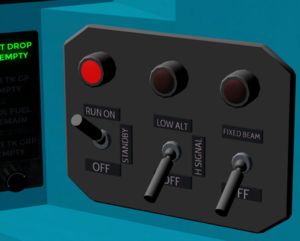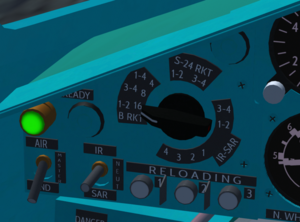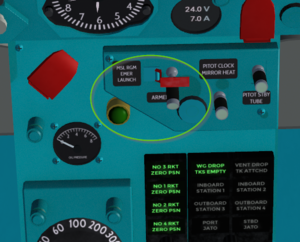MiG-21 Weapons Management
This page is about weapons management for the MiG-21bis.
Gunsight
The gunsight displays a static non-moveable fixed net and a moveable pipper onto the head-up-display. It must be turned on by flipping the Gunsight switch on the main switch panel on the right cockpit wall (bottom row, second switch from left).
The gunsight has customizable colours via the FlightGear dropdown menu MiG-21 -> Gunsight.
The Fixed Net
The fixed net is turned on using a switch on the bottom of the gunsight, and it's brightness can be adjusted using the knob on the bottom left of the gunsight.
The Pipper
The moving pipper uses an accelerometer, a gyro, and other inputs to attempt to accurately display where unguided armament is going. Most of the switches on the gunsight affect it in some way. The pipper is also affected by the throttle drum, which in-sim is moved with the i and k keys.
The pipper is turned on with a switch on the lower right side of the gunsight, and the brightness is changed by the knob directly above it.
The pipper's gyro can be disabled by turning the GYRO/MISS switch to MISS (left to gunsight, ca. middle). The pipper will be more stable, but less accurate. The pipper can be damped by pressing down the target lock key (n).
The pipper correction angle is set automatically via the position of the GUN/LAUNCH and SHOOT/BOMB switches. If SHOOT/BOMB is set to BOMB, the pipper attempts to help with bomb releases (this is not CCIP or CCRP, and is not accurate). If SHOOT/BOMB is set to SHOOT, and GUN/LAUNCH is set to GUN, the pipper angle will adjust to the correct angle for the GSh-23. If it is set to LAUNCH, it will adjust the angle depending on which armament position is selected on the weapons panel (S-5, S-24, or missiles).
Lights
The gunsight has three lights:
- The top left light indicates you are within launching parameters.
- The top right light indicates that you should break off the attack as soon as possible.
- The green light in the centre indicates that the gunsight is receiving radar information (in other words, that the radar has a lock).
Dials
The upper left dial shows distance for missile usage. The large central dial shows, in top to bottom order:
- pipper diameter in mils
- distance when using guns
- distance when using missiles
- distance when using rockets
Which gauge to read depends on which switches have been selected, and the position of the AIR/GROUND switch (on the weapons panel).
Radar
Before switching the radar on, it must be in Standby to warm up for 2-3 min (middle position of left most switch on radar panel on right cockpit wall). Before the radar is used, the left switch must be flipped up into the Run On position. The red light above will flash ca. 1 second and then turn off again. If it does not turn off, then the switch must be immediately set back to the middle position, as the radar was not warmed up sufficiently (not setting it back immediately might blow off the radar).
The radar can overheat due to the use of an open cooling system: ~25-30 min when on and ~2 hr in stand-by. If the red light on the right side of bottom of the radar turns on ("SW OFF RADAR"), the radar must be turned off.
Range:
The FlightGear implementation has a 60 km range and targets can be locked up up to 40 km. The radar sees 20° left/right and 20° up/down. This is not realistic, but currently done so to be competitive with other OPRF planes.
Format:
The radar shows contacts in B-scan format:
Tmeans contact is below you+means contact is roughly co-altitude with youɺ(upside down T) means contact is above you
Locking a target:
- Manoeuvre so the target is within the vertical bars on the radar display
- Move the lock bars over the target (using the i and k keys)
- Hit target lock n
Once a target is locked, the display changes to azimuth elevation: Range is indicated by the triangles on the two scales coming out of the centre to the left and right.
Identification Friend or Foe (IFF):
- Click the button labelled
IFFto toggle the interrogator (button situated on the radar panel above the radar).
At the moment the IFF implementation is not very realistic, as the radar will display the call-sign of all contacts.
GCI Integration:
There is a GCI integration by which the position of other aircraft can be requested and thereby helping the pilot to cope with the limitations of the radar. This only works if a OPRF asset GCI-radar is actually set up in vicinity. Positions are relative to the requester's plane, not a bullseye.
- Request Picture F5: the position of basically all planes
- Request Bogey Dope F6: position of the nearest enemy (bearing:range:altitude:aspect)
- Request Cutoff F7: intercept request (vector-heading:range:altitude:aspect - vector-heading is the heading and altitude to fly for a certain amount of time to intercept the target)
Weapons Information
Payload and Pylons
The hard-points are labelled as follows:
- Left wing inboard pylon
- Right wing inboard pylon
- Left wing outboard pylon
- Right wing outboard pylon
- Fuselage pylon
There are also a left and right fuselage attachment point, which currently only can be used for chaff/flare (in future versions of the FlightGear plane JATO rockets might get used).
| Name | Type | Guidance | Range | Speed | Pylons | Additional Info | Wikipedia article |
|---|---|---|---|---|---|---|---|
| R-3S | Missile | Infrared Homing (IR) | 8 km | Mach 2.5 | 1,2,3,4 | Russia-cloned AIM-9 | link |
| R-3R | Missile | Semi-Active Radar Homing (SAR[H]) | 8 km | Mach 2.5 | 1,2,3,4 | Russia-cloned AIM-9 | link |
| R-60 | Missile | IR | 8 km | Mach 2.7 | 1,2,3,4 | Can also be ported as a set of 2 on outboard pylons. More powerful than R-3S | link |
| R-27R1 | Missile | SAR | 73 km | Mach 4.5 | 1,2 | Later variants only | link |
| R-27T1 | Missile | IR | 63 km | Mach 4.5 | 1,2 | Later variants only | link |
| Kh-66 | Missile | Beam Rider | 10 km | 2700 km/h | 1,2,3,4 | Can be used on both air and ground targets | link |
| Kh-25MP | Missile | Anti Radiation | 42 km | 1620 km/h | 1,2 | link | |
| UB-16 | Rocket Pod | N/A | 1,2,3,4 | Fires S-5 rockets | |||
| UB-32 | Rocket Pod | N/A | 1,2 | Fires S-5 rockets | link | ||
| S-5 | Rocket | Unguided | 5 km | 300 m/s | Fired from UB-16/32 | Against soft ground targets | link |
| S-24 | Rocket | Unguided | 1,2,3,4 | Against hard ground targets | link | ||
| FAB-100 | A/G | Unguided | 1,2,3,4, | Free fall bomb 100 kg | |||
| FAB-100x4 | A/G | Unguided | 1,2 | Set of 4 100 kg bombs | |||
| FAB-250 | A/G | Unguided | 1,2,3,4 | Free fall bomb | |||
| FAB-500 | A/G | Unguided | 1,2 | Free fall bomb | |||
| RN-28 | A/G | Unguided | 5 | Tactical nuclear bomb. Intentionally not implemented in FlightGear | link | ||
| n/a | Smokepod | n/a | 5 | ||||
| PTB-490 | Droptank | n/a | 3,4,5 | 490 litres | |||
| PTB-500 | Droptank | n/a | 5 | 800 litres |
Weapons Loading
Load and re-load of weapons can be done on the ground. Most weapons are changed using the drop-down menu Equipment -> Fuel and Payload.
Flares/chaff can be added to the left and right fuselage attachment points (Conformal CM). They can be reloaded using drop-down menu MiG-21 -> Reload Flares/Chaff.
The gun is loaded on start-up of the simulation. Re-loading is currently only possible by re-starting FlightGear.
Gun
The gun needs to be powered on on the switch panel on the right cockpit wall. Choose the red switch on the left side of the bottom row. A green light on the weapons selection area on the left side of the fron panel will indicate that the gun is ready.
The pipper has three major "modes" of operation: automatic, manual, and 300m mode.
300m mode
300m mode is entered by rotating the throttle drum with the k button all the way to the rear. In this mode, the target distance is assumed to always be 300m, and the angle will be automatically set for the gun. Rotate the span knob to set the desired target wingspan width in meters.
The pipper will show the point where the bullets will be when they are 300 m away from you. Manoeuvre such that the pipper is on the target. When the pipper's diamonds touch the wingtip and the wingspan was set correctly, then you are 300 m away and ready to fire by pulling the trigger f.
Auto mode
Automatic mode is entered into by not being in 300m mode, and by flipping the AUTO/MAN switch to MAN.
Span still must be set manually.
Distance is taken from either a radar lock, the slant-radar range (if the radar is locked in the forward position), or if neither is present, the distance is assumed to be 600m.
Manual Mode
In manual mode, the span and angle must be entered manually. When the target is within visual range, use the i and k keys to move the pipper diamonds so they surround the target. Range to the target will be estimated based on the wingspan and pipper diameter. Note that while in manual mode, the locking bars on the radar cannot be moved.
Unjamming
Guns can get jammed. If it happens, press one of the unjam buttons (labelled 1, 2, 3 near the weapon selector).
Other Weapons Armament and Deployment
Make sure to power on the respective pylons etc. using the switches on the second row from below on the switch panel on the right cockpit wall. The red switch labelled MSL RGM RKT LCH can be held in the down position as a security until bombs, rockets or missiles need to be released.
Unguided Free Fall Bombs
To set the correct angle of the pipper use the information included in the bombing_data.csv file (situated in the top level folder of the aircraft) to set the pipper depression angle using the top right wheel on the gunsight with the red gauge and label Angle.
Put the pipper on the target and monitor the bottom range band of the gun sight (scale from 0.4 to 2 km): drop bombs from 1.5 km or higher by holding the WEAPONS RELEASE button. You will have a visual cue when the LAUNCH ALLOWED light is lit up.
The weapon selector needs to be in B RKT at the appropriate pylons. When pressing armament release, a single bomb will be dropped from each of the selected pylons.
Remember to arm the bombs before you drop them - otherwise you will not see any impact.
Rockets
There is a ripple setting for launching rockets. However, please be aware that if the button / keyboard control (q) is only pressed shortly, then only one rocket is released no matter the ripple setting. Therefore: hold down the button the whole time.
Rocket aiming is a lot like gun aiming using the pipper and the fixed net. Rockets basically act like bullets (due to limits in the current implementation). Contrary to the cannon, the following two switches are in a different position:
- On the left side of the HUD: top switch should be on
LNCinstead ofGUN. - On the left side of the HUD under the drum: the lever should be in the down position
MISSinstead of the up positionsSHOT.
UB-16/UB-32
The pylon selector must be in one of the three selection possibilities inB RKT. The numbers represent the amount of rockets to salvo fire from each wing.
S-24
The pylon selector must be set to the inboard or outboard stations in S-24 RKT. Rockets from both of the selected pylons will be salvo launched when pressing the weapons release.
Air-to-Ground Missiles
'KH-66
The KH-66 (aka. "Gorm") requires the radar in beam mode (set right most switch on the radar panel on the right cockpit wall to Fixed Beam). The beam mode locks the radar forward centre and downwards 1.5 degrees (indicated by a fixed pipper in that position).
The weapon selector to the appropriate IR-SAR position. The position determines the priority pylon, but once it's fired you can fire a next one without changing to a new pylon. The IR-SAR switch below the weapon selector must be set to SAR.
Radar lock is not necessarily required. It is hard to aim, but fun.
Kh-25MP
Is an anti-radiation missile, which can only be fired "mad dog" (firing without a lock) and therefore radar does not matter. It can be fired at anything on the ground (e.g. GCI, SAM) or in the air (e.g. AWACS) emitting radar - however due to a missing radar lock and fired "mad dog" they might hit friends instead of foes (attacks first thing it sees). Air targets are hard to hit due to low manoeuvrability and low g-load tolerance.
The weapon selector must be set to the appropriate S-24 RKT position. The position of the IR-SAR switch does not matter.
The missile tends to angle up from the nose direction, so it should be aimed a bit lower than normally expected (using the cross of the fixed net - not the pipper!).
Pay attention to the fact that after the launch the roll tendency of the plane will be high due to the asymmetrical load.
Air-to-Air Missiles
IR (FOX 2)
Set the weapon mode selectors to Air and IR. The pylon selector must be set to IR-SAR with the appropriate pylon.
Manoeuvre so that the target is roughly in the centre of the gun sight. When one of the 3 green lights directly to the lower right of the gunsight lights up, then the seeker has locked on a target. Press the weapons release button.
SAR (FOX 1)
Set the weapon mode selectors to Air and SAR. The pylon selector must be set to IR-SAR with the appropriate pylon.
Radar on (description about radar below) and target locked. Press the weapons release button. Since it's a semi-active radar homing missile, the lock needs to be maintained until the missile hits by keeping the nose somewhat pointed towards the target.
Flares / Chaff
The current CM “pods” are Yugoslavian in origin, and there isn't much info online about them. The implementation assumes the front 9 holes were for chaff, and the rear 20 were for flares.
Radar Warning Receiver (RWR)
Flashing light and tone indicate one or several aircraft being picked up. The 4 lights represent the approximate directions. The faster the flashes, the closer. Steady is launch.
The RWR can be toggled between Day (yellow lights) and Night (red lights) by pressing on the gauge - but not in the middle, as that is the test button).
Each of the four light bulbs represents one of the four sensors, not the system as a whole. Depending on the relative position of the other aircraft, more than one light bulb might be on, as the aspect ranges of the sensors overlap each other. If there is more than one aircraft in range, then the blinking of the light bulbs might get infrequent/not constant rhythm, as each aircraft's radar scan passes over the sensors.
Examples of lit light bulbs:
X |
--+--
|
Means there's one or more aircrafts forward/right of you.
X | X
--+--
|
There are two possibilities:
- An aircraft directly in front at 12 o'clock position
- One or more aircrafts forward of you both to the left and to the right
In the real aircraft the blink rate is based on aircraft, scan pattern, and distance. However, that has not yet been implemented in FlightGear.


